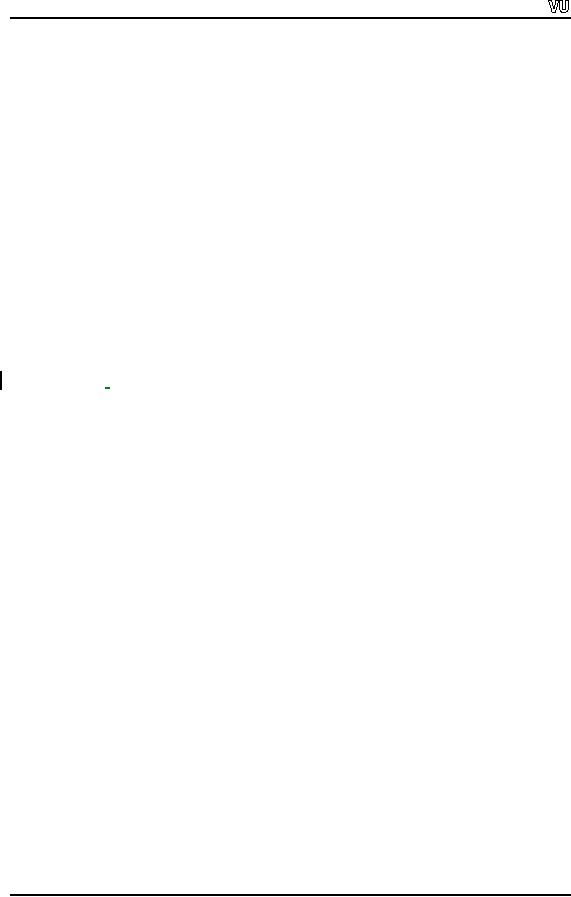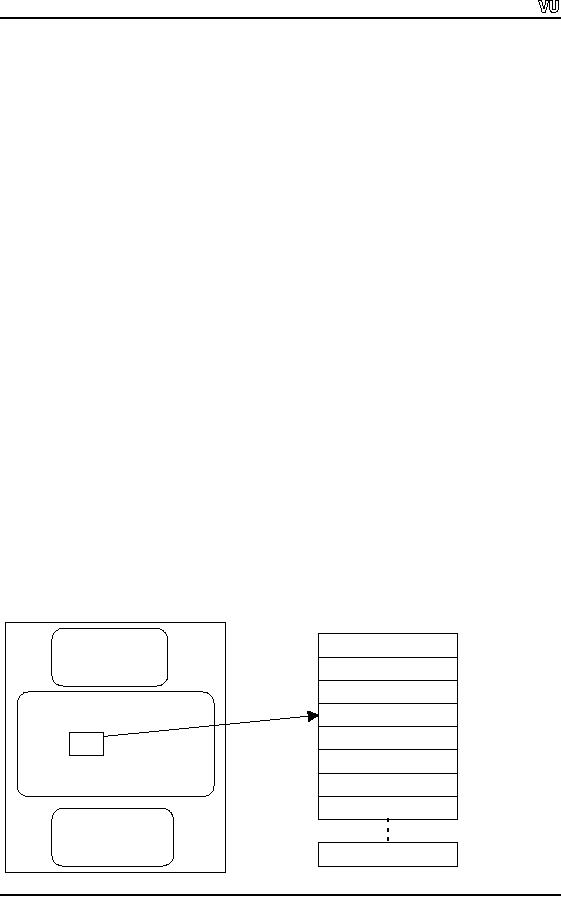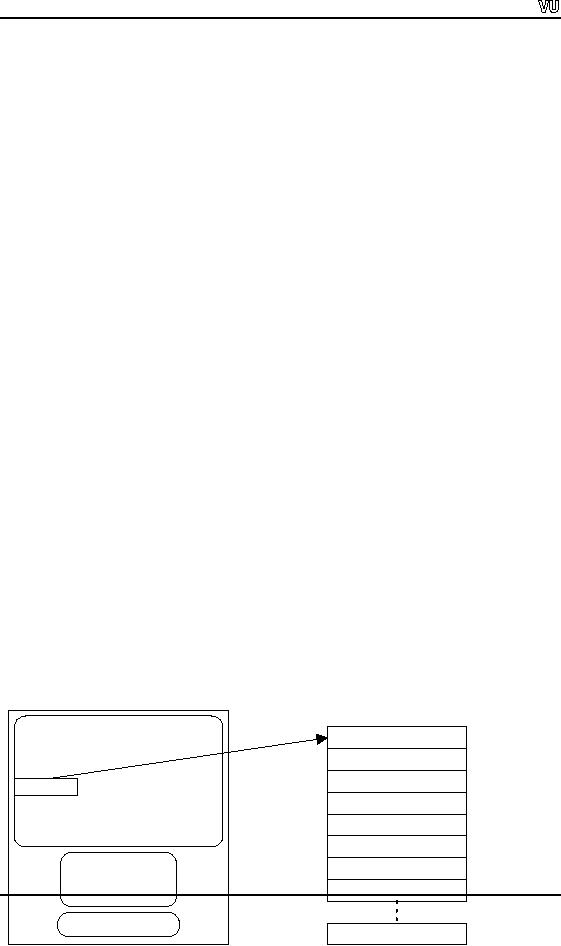 |

CS201
Introduction to Programming
Lecture
Handout
Introduction
to Programming
Lecture
No. 28
Reading
Material
Deitel
& Deitel - C++ How to
Program
Chapter
7
7.6,
7.8
Summary
�
Lecture
Overview
�
Memory
Allocation in C
�
Memory
Allocation in C++
�
new
Operator and Classes
�
Example
Program 1
�
Classes
and Structures in C++
�
new
Operator and
Constructors
�
delete
Operator and Classes
�
Example
Program 2
�
new,
delete outside Constructors
and Destructors
�
main()
Function and Classes
�
Class
Abstraction
�
Messages
and Methods
�
Classes
to Extend the
Language
�
Tips
Lecture
Overview
In the
previous lectures, we have been
discussing about Classes,
Objects, Constructors
and
Destructors. In this lecture we
will take them further while
discussing Memory
Allocation.
We'll
see how the memory
allocation is done in C++,
while discussing
memory
-
allocation
in C?
Page
346

CS201
Introduction to Programming
How
C++ style is different from
the C-style of allocation
discussed earlier?
-
What
are the advantages of C++
approach as compared to that of
C?
-
Memory
Allocation in C
Before further
proceeding with the concept
of memory, it is better to know
what else we
can
create with classes besides
objects.
Recapturing
of the concept of `structures' can
help us to move forward.
Consider the
following
statement.
struct
abc
{
int
integer;
float
floatingpoint;
};
We could
have declared a structure object
as:
struct
abc xyz;
//
Declared an object of structure
type
and
access data members inside
structure by using dot
operator (".") as:
xyz.integer
= 2134;
xyz.floatingpoint
= 234.34;
Similarly,
we could have a pointer to a structure object
as:
struct
abc* abcPtr; // Declared a pointer of a
structure type
abcPtr =
xyz;
// Pointer is
pointing to xyz object
now
We can
access the individual data
member as:
abcPtr->integer
= 2134;
abcPtr->floatingpoint
= 234.34;
We can
have pointers to different
data structures, similarly, pointer to a
class object. Here
we are
going to discuss about Pointers,
Classes and Objects.
Let's
start by talking about
memory allocation. We introduced few functions of
memory
allocation
in C: malloc(), calloc()
and
realloc(). Using
these functions, memory is
allocated
while the program is running.
This means while writing
your program or at
compile
time, you don't need to
know the size of the memory
required. You can
allocate
memory at
runtime (dynamically) that
has many benefits. The
classic example will be of
an array
declared to store a string. If the length
of the actual string is lesser
than the size
of the
array, then the part
that remains unoccupied will
be wasted. Suppose we declare
an
array of
length 6
to
contain student name. It is alright if
the student name is let's
say
Jamil
but
what will happen for
the student named Abdul
Razzaq. This is
a case where
dynamic
memory allocation is
required.
Page
347

CS201
Introduction to Programming
In C
language, the region of memory
allocated at runtime is called heap.
However, in
C++,
the region of available memory is called
free
store. We have
different functions to
manipulate
memory in both C and
C++.
You
know that while using malloc(), we have
to tell the number of bytes
required from
memory
like:
malloc(number
of bytes required to be
allocated);
Sometimes, we
also do a little manipulation
while calculating the number
of bytes
required
to be allocated: i.e.
malloc(
10 * ( sizeof(int) ) );
The
malloc()
returns a
void pointer (void
*). A
pointer that points to a void type
of
memory.
So in order to use this
memory, we have to cast it to
our required type.
Suppose,
we want
to use it for ints. For
this purpose, you will
cast this returned void
pointer to int
*
and
then assign it to an int *
before
making its further use. The
following code is an
example of
malloc()
usage.
class
Date
{
public:
Date( )
;
Date(int month,
int day, int
year);
~Date ( )
;
setMonth(
int month ) ;
setDay(
int day ) ;
setYear(
int year ) ;
int
getDay ( ) ;
int
getMonth ( ) ;
int
getYear ( ) ;
setDate(int
day, int month, int
year);
private:
int
month, day, year;
};
Date
*datePtr;
//
Declared a pointer of Date
type.
int
i;
datePtr =
(Date *) malloc( sizeof(
Date ) );
// Used
malloc() to allocate
memory
i =
datePtr->getMonth();
//
Returns undefined month
value
So there
is some house-keeping involved
during the use of this
function. We have to
determine
the number of bytes required
to be allocated and cast the
returned void pointer
to our
required type and then
assign it to a variable pointer. Lastly,
the memory returned
from
this function is un-initialized
and it may contain
garbage.
Page
348

CS201
Introduction to Programming
The
contrasting function used to
free the allocated memory
using malloc()
is
free()
function.
As a programmer, if you have allocated
some memory using malloc(), it is
your
responsibility
to free it. This
responsibility of de-allocation will be
there while using
C++
functions.
But these new functions are
far easier to use and more
self-explanatory.
Memory
Allocation in C++
The
memory allocation in C++ is
carried out with the
use of an operator called new.
Notice
that new is an operator
while the malloc()
was a
function. Let's see the
syntax of
new
operator
through the following
example.
new
int;
In the
above statement, the new
operator is allocating memory
for an int
and
returns a
pointer of
int
type
pointing to this region of
memory. So this operator not
only allocated
required
memory but also
spontaneously returned a pointer of
required type without
applying
a cast.
In our
program, we
can write it as:
int
*iptr;
iptr =
new int;
So while
using new
operator,
we don't need to supply the
number of bytes
allocated.
There is
no need to use the sizeof
operator
and cast the pointer to the
required type.
Everything
is done by the new
operator
for us. Similarly, new
operator can be used
for
other
data types like char, float
and
double
etc.
The
operator to free the
allocated memory using new
operator
is delete. So
whenever, we
use
new
to
allocate memory, it will be
necessary to make use of `delete' to
de-allocate
the
allocated memory.
delete
iptr;
The
delete
operator
frees the allocated memory
that is returned back to
free store for
usage
ahead.
What if
we want to allocate space
for any array? It is very
simple. Following is
the
syntax:
new
data_type [number_of_locations];
For
example, we want to allocate an array of
10 ints
dynamically. Then the
statement
will be
like this:
int
*iptr;
iptr =
new int[10];
What it
does is, it tries to occupy memory space
for 10 ints in
memory. If the memory
is
occupied
successfully, it returns int
* that is
assigned to iptr.
Page
349

CS201
Introduction to Programming
Whenever
we allocate memory dynamically, it is
allocated from free store.
Now we will
see
what happens if the memory
in the free store is not
sufficient enough to fulfill
the
request.
malloc()
function
returns NULL
pointer if
the memory is not enough. In
C++, 0
is
returned instead of NULL
pointer.
Therefore, whenever we use
new
to
allocate
memory,
it is good to check the
returned value against 0
for
failure of the new
operator.
Remember,
new
is an
operator,it is not a function.
Whenever we use new, we
don't use
parenthesis
with it, no number of bytes
or sizeof
operator
is required and no cast
is
applied to
convert the pointer to the
required type.
delete
operator
is used to free the memory
when the allocation is done
by using new
as
shown
below:
int
*iptr;
iptr =
new int [10]; // Memory
for 10 ints is
allocated dynamically.
delete
iptr;
//
Allocated is freed and
returned to the free
store.
Can we
apply the concept of dynamic
memory allocation/deallocation while
using
new/delete
with classes and objects?
The answer is obviously
yes.
new
Operator and
Classes
As we
declare a pointer to a primitive
datatype, similarly, we can
have a pointer to a
class
object.
Date
*dptr; // dptr is a pointer to an object
of type Date.
Now, we
create the object using the
new
operator. Remember, the
basic definition of a
class
i.e. it is a
user-defined data type. In other
words, the language has
been extended to a
programmer to
have user defined data
types. When we use them in our
programs, these
are
used in the same manner as
the primitive data
types.
dptr =
new Date;
Date
class
main (
)
0
{
0
Date*
=
new
Date();
dptr
...
0
...
}
BasicData
class
Page
350
Free
Store
Process
(Program in
memory)
�

CS201
Introduction to Programming
Whatever
amount of memory is required
for a Date object, is allocated
from the free
store. A
pointer to of Date type is returned back
and assigned to the dptr
pointer
variable.
Is this
all what new is doing? If it
is so, can we use malloc()
function
by providing
number of
bytes required for Date
object
with the help of sizeof
operator.
The answer to
this
question lies in the further
discussion.
Date
mydate;
cout
<< sizeof (mydate);
As
discussed in the last
lecture, whenever we instantiate an
object of a class, the
data
members
are allocated for each
object. However, the member functions occupy
a
common
region in memory for all
objects of a class. Therefore,
sizeof
operator
returns
the size
of the data-members storage
excluding the member functions part. In
the above
statement,
the sizeof
operator
returns the sum of the
sizes of three integers day, month
and
year,
declared in the Date
class.
The
amount of memory allocated in
the above statement using
new
(dptr
= new
Date;) is
same as reflected in the
following statement:
dptr =
(Date *) malloc( sizeof(Date) );
The
new
operator
in the above statement ( dptr =
new Date;) has
automatically
determined
the size of the Date
object
and allocated memory before
returning a pointer of
Date
* type. Is
this all what new is
doing? Actually, it is doing more than
this. It is also
creating
an object of type Date. C functions
like malloc()
do
nothing for object creation.
Rather
these C functions allocate the
required number of bytes and
return a void
*
pointing
to the allocated memory where
the memory might contain
garbage. But the new
operator
not only allocates the
memory after automatically determining
the size of the
object
but also creates an object
before returning a pointer of object's
class type.
Additionally,
within the call to the
new
operator,
the memory assigned to the
created
object
with the use of new
operator
can be initialized with
meaningful values instead
of
garbage
(think of C functions like malloc()
).
How
the data members are
initialized with meaningful
values? Actually, a constructor
is
called
whenever an object is created. Inside
the constructor, individual
data members can
be
initialized. The C++
compiler generates a default constructor
for a class if the
programmer
does not provide it. But
the default constructor does
not perform any
data
members
initialization. Therefore, it is good
practice that whenever you
write a class, use
a
constructor function to initialize
the data members to some
meaningful values.
Whenever
new
operator
is used to create an object, following
actions are performed by
it:
- It automatically
determines the size of the
memory required to store
that object,
leaving no
need for the use of
sizeof
operator.
- Calls the
constructor of the Class, where
the programmers normally
write
initialization
code.
Page
351

CS201
Introduction to Programming
Returns
pointer of the class type that
means no casting is
required.
-
Hence,
new
operator
is extremely useful, powerful and a
good way of allocating
memory.
Let's
suppose, we want to allocate
space for 10 ints as
under:
int *
iptr;
iptr =
new int [10];
This
new
statement
allocates contiguous space
for an array of 10 ints and
returns back
pointer to
the first int. Can we
do this operation for
objects of a class? The
answer to this
question
is yes. The syntax in this case
will be identical. To create an
array of 10 objects
of Date
type, following code is
written:
Date *
dptr;
dptr =
new Date [10];
int
day = dptr->getDay();
Here the
new
operator
allocates memory for 10 Date
objects.
It calls the default or
parameter-less
constructors of the Date
class
and returns the pointer to
the first object,
assigned
to the dptr
variable.
Arrow operators (->) is
used while accessing functions
or
data
members from the pointer
variable.
Example
Program 1
/*
Following program demonstrates the
new operator. This program
has the problem of
memory
leak because delete operator is not
called for the allocated
memory. */
#include
<iostream.h>
class
MyDate
{
public:
// public members are
below
/*
Parameterless constructor of MyDate
class */
MyDate(
)
{
cout <<
"\n Parameterless constructor called
...";
month =
day = year = 0;
// all
data member initialized to 0
}
/*
Parameterized constructor of MyDate
class. It assigns the
parameter values to
the
........data
members of the class
*/
MyDate(int
month, int day, int
year)
{
cout <<
"\n Constructor with three
int parameters called
...";
Page
352

CS201
Introduction to Programming
this->month
= month; // Notice the use
of arrow operator ( -> )
this->day =
day;
this->year =
year;
}
/*
Destructor of the MyDate
class */
~MyDate (
)
{
cout
<< "\n Destructor called
...";
}
/* Setter
function for the month
data
member. It assigns the parameter
value to
the
month
data
member */
void
setMonth ( int month )
{
this->month
= month;
}
/* Setter
function for the day
data
member. It assigns the parameter
value to the
day
data
member */
void
setDay ( int day )
{
this->day =
day;
}
/* Setter
function for the year
data
member. It assigns the parameter
value to the
year
data
member */
void
setYear ( int year )
{
this->year =
year;
}
/* Getter
function for the day
data
member. It returns the value of
the day
data
member
*/
int
getDay ( )
{
return
this->day;
}
/* Getter
function for the month
data
member. It returns the value of
the
month
data
member */
int
getMonth ( )
{
Page
353

CS201
Introduction to Programming
return
this->month;
}
/* Getter
function for the year
data
member. It returns the value of
the year
data
member
*/
int
getYear ( )
{
return
this->year;
}
/* A
function to set all the
attributes (data members) of
the Date object */
void
setDate ( int day, int
month, int year )
{
this->day =
day;
this->month
= month;
this->year =
year;
}
private:
// private
members are below
int
month, day, year;
};
main(void)
{
MyDate
*dptr;
//
Declared a pointer dptr
to
MyPointer class object
dptr =
new MyDate [10];
//
Created 10 objects of MyDate
and assigned the
// pointer to
the first object to dptr pointer
variable.
// delete
should have been called here
before the program
terminates.
}
The
output of this example program is as
follows:
Parameterless
constructor called ...
Parameterless
constructor called ...
Parameterless
constructor called ...
Parameterless
constructor called ...
Parameterless
constructor called ...
Parameterless
constructor called ...
Parameterless
constructor called ...
Parameterless
constructor called ...
Parameterless
constructor called ...
Parameterless
constructor called ...
Notice
that the constructor is called 10
times with 10 new
calls
but there is no call
to
destructor.
What is the reason? The
objects are created with
the new
operator
on free
Page
354

CS201
Introduction to Programming
store,
they will not be destroyed
and memory will not be
de-allocated unless we
call
delete
operator
to destroy the objects and
de-allocate memory. So memory
allocated on
free
store is not de-allocated in
this program and that
results in memory leak.
There is
another
point to be noted in this example
program, which is not
relevant to our topics of
discussion
today that all the functions
are requested to be inline
automatically
as the
functions
are defined within the
class body.
Classes
and Structures in
C++
Structures
and classes in C++ are quite
similar. C++ structure is
declared with the
same
keyword
struct
as in
C. Unlike C structure, C++
structure can have data
and member
functions.
The difference between class
and structure is of visibility.
Every data member
or
function written inside the
structure is public
(visible
from outside) by default
unless
declared
otherwise. Similarly, everything declared inside a
class is private
(not
visible
from
outside) by default unless declared as
public.
While
writing classes, good
programming practice is to write
private
keyword
explicitly,
despite
the fact that this is the
default behavior. Similarly, while
writing structures, it is
good to
write the public
keyword
explicitly. This averts confusion
and increases
readability.
Another
good practice is to write public
or
private
keywords
only once in the class
or
structure
declaration, though there is no
syntactical or logical problem in writing
them
multiple
times.
Also
remember while writing a
class or a structure that
once a keyword is written,
say
public,
the
declarations falling below
this keyword will be public
until
the private
keyword
is mentioned.
There is
another keyword protected. We
are not using this keyword
in this course
because
that
deals with inheritance that
is a part of Object Oriented Programming, a
separate
course.
new
Operator and
Constructors
It is
clear that whenever new
operator
is called to create an object, the
constructor is also
called
for that object. What will
happen if we have to call
new from inside a
constructor
function.
Can we do that? The answer
is definitely yes. There are
times when we have to
do
dynamic memory allocation or create
new objects from inside a
constructor. For
example, we
have a Student
class
with attributes i.e. roll
number, age, height
and
Student
class
J
{
public:
a
Student(char*
name)
{
m
this->name =
new char (strlen(name)+1)
;
srcpy(
this->name, name) ;
i
}
...
l
}
\0
main (
)
{
Page
355
...
}
BasicData
class
Process
Free
Store
(Program in
memory)

CS201
Introduction to Programming
name. The
attributes like roll
number, age
and
height
can be
contained in ints or floats
but
the name
attribute
will require a string. Because
of the nature of this attribute
(as it
can
have different lengths for
different students), it is better to
use dynamic memory
allocation
for this. So we will use new
operator
from within the constructor
of Student
class to
allocate memory for the
name
of
the student.
We know
whenever we use new
to
allocate memory, it is our
responsibility to de-allocate
the
memory using the delete
operator.
Failing which, a memory
leak will
happen.
Remember,
the memory allocated from
free
store or heap
is a
system resource and is
not
returned
back to the system ( even if
the allocating program
terminates ) unless
explicitly
freed
using delete
or
free
operators.
Now, we
will see how the
delete
works
for objects and what is
the syntax.
delete
Operator and
Classes
As in our
Student
class, as
we will be allocating memory
from within the constructor
of
it.
Therefore, there is a need to
call delete
to
de-allocate memory. What is
the appropriate
location
inside the class Student
to
call delete
operator
to de-allocate memory? In
normal
circumstances, the location is
the destructor of a class
(Student
class's
destructor
in this
case). The destructor is
used to de-allocate memory
because it is called when
the
object is no more
needed or going to be destroyed from
the program's memory. So this
is
the
real usefulness of destructors
that these are used to
release the system
resources
including
memory occupied by the
objects.
As a
thumb rule , whenever there is a pointer
data member inside our class
and pointer is
being
used by allocating memory at
runtime. It is required to provide a
destructor for that
class to
release the allocated
memory. A constructor can be
overloaded but not a
destructor.
So there is only one
destructor for a class. That
one destructor of a class
must
do house
keeping before the object is
destroyed. Normal data
members int, char, float
and
double, not
allocated using malloc()
or
new
operator,
don't need to be
de-allocated
using
free()
or
delete. These
are automatically
destroyed.
Let's be
sure that free()
is
used with malloc()
function
while delete
operator
with new
operator.
Normally, new
will be
called in a constructor. However, delete
will be
called in
the
destructor.
Example
Program 2
/*
Following program demonstrates the
new and delete operators. It
deallocates the
memory
properly before terminating. */
#include
<iostream.h>
class
MyDate
Page
356

CS201
Introduction to Programming
{
public:
//public
members are below
/*
Parameterless constructor of MyDate
class */
MyDate(
)
{
cout <<
"\n Parameterless constructor called
...";
month =
day = year = 0;
// all
data member initialized to 0
}
/*
Parameterized constructor of MyDate
class. It assigns the
parameter values to
the
........data
members of the class
*/
MyDate(int
month, int day, int
year)
{
cout <<
"\n Constructor with three
int parameters called
...";
this->month
= month; // Notice the use
of arrow operator ( -> )
this->day =
day;
this->year =
year;
}
/*
Destructor of the MyDate
class */
~MyDate (
)
{
cout
<< "\n Destructor called
...";
}
/* Setter
function for the month
data
member. It assigns the parameter
value to
the
month
data
member */
void
setMonth ( int month )
{
this->month
= month;
}
/* Setter
function for the day
data
member. It assigns the parameter
value to the
day
data
member */
void
setDay ( int day )
{
this->day =
day;
}
/* Setter
function for the year
data
member. It assigns the parameter
value to the
year
data
member */
void
setYear ( int year )
Page
357

CS201
Introduction to Programming
{
this->year =
year;
}
/* Getter
function for the day
data
member. It returns the value of
the day
data
member
*/
int
getDay ( )
{
return
this->day;
}
/* Getter
function for the month
data
member. It returns the value of
the
month
data
member */
int
getMonth ( )
{
return
this->month;
}
/* Getter
function for the year
data
member. It returns the value of
the year
data
member
*/
int
getYear ( )
{
return
this->year;
}
/* A
function to set all the
attributes (data members) of
the Date object */
void
setDate ( int day, int
month, int year )
{
this->day =
day;
this->month
= month;
this->year =
year;
}
private:
// private
members are below
int
month, day, year;
};
main(void)
{
MyDate
*dptr;
//
Declared a pointer dptr
to
MyPointer class object
dptr =
new MyDate [10];
//
Created 10 objects of MyDate
and assigned the
// pointer to
the first object to dptr pointer
variable.
delete []
dptr;
//
Deleted (freed) the assigned
memory to the objects
}
Page
358

CS201
Introduction to Programming
The
output of this example program is as
follows:
Parameterless
constructor called ...
Parameterless
constructor called ...
Parameterless
constructor called ...
Parameterless
constructor called ...
Parameterless
constructor called ...
Parameterless
constructor called ...
Parameterless
constructor called ...
Parameterless
constructor called ...
Parameterless
constructor called ...
Parameterless
constructor called ...
Destructor called
...
Destructor called
...
Destructor called
...
Destructor called
...
Destructor called
...
Destructor called
...
Destructor called
...
Destructor called
...
Destructor called
...
Destructor called
...
It is
very clear from the output
that the destructor for
all the objects is called to
avert any
memory
leak. The memory allocated
using new operator is being
de-allocated using
the
delete
operator. Notice the syntax of
delete
while
de-allocating an array, the brackets
([])
precedes
the name of the array
after the delete
operator.
new,
delete outside Constructors
and Destructors
Can
new
be
called from some location
other than constructor? The
answer is yes and we
usually
need to do that. Suppose, we
have an object of Student
class.
The name of the
student
is: Abdul
Khaliq. So for
the name
attribute,
the space is allocated
dynamically to
store
the string Abdul
Khaliq. When
our program is running and we
have already
allocated
space for the Abdul
Khaliq string
using the new
operator,
after sometime, we
are
required to increase the size of
the string. Let's say we
want to change the string
to
Abdul
Khaliq Khan now.
So what
we can do, without destroying
this student object:
De-allocate
the name
previously
occupied string using the delete
operator,
determine the
size of
memory required with the
help of strlen()
function,
allocate the memory
required
for
the new string Abdul
Khaliq Khan using
the new
operator
and finally assign
the
returned
pointer to the name
data
member.
Hence, we
can call new
and
delete
operators,
not only outside the
class to create
objects
but
also within the class.
The objects of the same
class can have different
sizes of
Page
359

CS201
Introduction to Programming
memory
space like in case of
objects of Student
class,
student 1 object can be of one
size
and
student 2 object can be of an another
size, primarily varying because of string
name.
But
independent of this object size, the
destructor of the object remains
the same and
de-
allocates
memory for different objects
regardless of their different sizes.
delete
operator
is used
from within the destructor
to deallocate the memory. We
call delete
operator
to
determine
the size of the memory
required to be de-allocated and
only provide it a pointer
pointing
to it.
Please
note that C functions like
malloc()
and
free()
functions
can also be used
from
within
C++ code. But while
writing classes inside C++
code, we prefer to use new
and
delete
operators
as they are designed to work
with classes and
objects.
main()
Function and
Classes
We used
to discuss about main()
function a lot while writing
our programs in C.
You
might
have noticed that while
discussing about classes and
objects, we are not
talking
about
the main()
function.
This does not mean
that main()
function
is not there in C++. It
is there
but it does not contain as much
code in C++ . But as you go
along and write
your
own
classess, you will realize
that almost 90% of your program's
code lies inside the
class
definitions. So firstly we write
our classes and main()
function
is written after
classes
have been defined. That is
why the main()
function
is very small. Our example
programs
clearly depict this fact.
Class
Abstraction
Whenever
we write a class, we think
about its users. Who
are the ones going to use
this
class?
The users are not
only the main()
function
of the program but also our
colleagues
around
us. Remember, we only expose
interface to our users and
not the class
implementation.
All what users need to know
is provided in the interface, the
methods
signatures
and what can be achieved by
calling that method. The
users do not need to
know
how the functions or interfaces
are implemented, what are
the variables, how is
the
data
inside and how is it being manipulated,
it is abstract to the
users.
Messages
and Methods
When we
create an object, we ask that object to
do something by calling a function.
This
way of
asking objects in Windows
operating system is called Messaging or
in other
words
function calling is sending a
message to the object. Sending a
message is a
synonym
of calling a method of an object. The
word `method' is from the
fact that it is a
way of
doing something. So the whole program is
sending messages and
getting
responses
back. It is a different way of
looking at things.
Page
360

CS201
Introduction to Programming
Notice
lot of things have been
repeated in this lecture
many times, the reason is
that now,
you
are required to think
differently, more in terms of classes
and objects. There are
lots
of
exciting things coming up to be covered
later.
Classes
to Extend the
Language
We know
that in C, there is no data type
for complex numbers.
Therefore, we needed to
define
our own class for
complex numbers. We might
use double
data type
for real
and
imaginary
parts.
From basic Mathematics, we also
know that whenever two
complex
numbers
are added, real part of
one complex number is added
into the real part of
other
complex
number and imaginary part of
one complex number is added
into the imaginary
part of
other complex number. We
might write a function for
this operation and
might
call this
as cadd(). We
might also write other
functions for multiplication and
division. In
C++,
the operators like `+', `*'
and `/' can be overloaded,
therefore, we could overload
these
operators for complex
numbers, so that we could easily use
these ordinary addition,
multiplication,
and division operators for
complex numbers. Actually, we
don't need to
write
this class on our own
because this is already been
provided in many C++ libraries.
Remember,
there is no primitive data type in
C++ for complex numbers
but a class has
been
written as part of the many
C++ libraries. Moral of the
above paragraph is; by
using
user
defined data types i.e., classes, we
can now really extend
the language.
Tips
Classes
are one way of extending the
C++ language.
-
Whenever
new
operator
is used, no number of bytes or
sizeof
operator
is required and
-
no cast
is applied to convert the pointer to the
required type.
Whenever
new
operator
is called to create an object, the
constructor is also called
for
-
that
object. It is a good practice that
whenever you write a class,
use a constructor
function
to initialize the data
members to some meaningful
values.
The
usual practice is to use
constructor to allocate memory or
system resources and
-
destructors
to de-allocate or return the
resources back to the
system.
In C
language, the region of memory
allocated at runtime is called heap.
However, in
-
C++,
the region of available memory is called
free
store. There
are different
functions in C
and C++ to manipulate memory at
runtime. However, all C
functions
are
useable in C++ code.
The
memory allocated from free
store or heap
is a
system resource and is
not
-
returned
back to the system unless
explicitly freed using delete
or
free
operators.
Page
361

CS201
Introduction to Programming
If the
memory in the free store is
not sufficient enough to
fulfill the request, malloc()
-
function
returns NULL
pointer.
Similarly, the new function
returns 0
in
case the
request
could not be
fulfilled.
Whenever
we use new
operator,
the returned value from the
new
should be
checked
-
against
0
for
any possible failures.
While
writing classes, good
programming practice is to write
private
keyword
-
explicitly,
despite the fact that this
is the default scope. Additionally,
the good
practice
is to write public
or
private
keywords
only once in the class or
structure
definitions,
though there is no syntactical or logical
problems in writing them
multiple
times.
Page
362
Table of Contents:
- What is programming
- System Software, Application Software, C language
- C language: Variables, Data Types, Arithmetic Operators, Precedence of Operators
- C++: Examples of Expressions, Use of Operators
- Flow Charting, if/else structure, Logical Operators
- Repetition Structure (Loop), Overflow Condition, Infinite Loop, Properties of While loop, Flow Chart
- Do-While Statement, for Statement, Increment/decrement Operators
- Switch Statement, Break Statement, Continue Statement, Rules for structured Programming/Flow Charting
- Functions in C: Structure of a Function, Declaration and Definition of a Function
- Header Files, Scope of Identifiers, Functions, Call by Value, Call by Reference
- Arrays: Initialization of Arrays, Copying Arrays, Linear Search
- Character Arrays: Arrays Comparisonm, Sorting Arrays Searching arrays, Functions arrays, Multidimensional Arrays
- Array Manipulation, Real World Problem and Design Recipe
- Pointers: Declaration of Pointers, Bubble Sort Example, Pointers and Call By Reference
- Introduction, Relationship between Pointers and Arrays, Pointer Expressions and Arithmetic, Pointers Comparison, Pointer, String and Arrays
- Multi-dimensional Arrays, Pointers to Pointers, Command-line Arguments
- String Handling, String Manipulation Functions, Character Handling Functions, String Conversion Functions
- Files: Text File Handling, Output File Handling
- Sequential Access Files, Random Access Files, Setting the Position in a File, seekg() and tellg() Functions
- Structures, Declaration of a Structure, Initializing Structures, Functions and structures, Arrays of structures, sizeof operator
- Bit Manipulation Operators, AND Operator, OR Operator, Exclusive OR Operator, NOT Operator Bit Flags Masking Unsigned Integers
- Bitwise Manipulation and Assignment Operator, Programming Constructs
- Pre-processor, include directive, define directive, Other Preprocessor Directives, Macros
- Dynamic Memory Allocation, calloc, malloc, realloc Function, Dangling Pointers
- History of C/C++, Structured Programming, Default Function Arguments
- Classes and Objects, Structure of a class, Constructor
- Classes And Objects, Types of Constructors, Utility Functions, Destructors
- Memory Allocation in C++, Operator and Classes, Structures, Function in C++,
- Declaration of Friend Functions, Friend Classes
- Difference Between References and Pointers, Dangling References
- Operator Overloading, Non-member Operator Functions
- Overloading Minus Operator, Operators with Date Class, Unary Operators
- Assignment Operator, Self Assignmentm, Pointer, Conversions
- Dynamic Arrays of Objects, Overloading new and delete Operators
- Source and Destination of streams, Formatted Input and Output, Buffered Input/Output
- Stream Manipulations, Manipulators, Non Parameterized Manipulators, Formatting Manipulation
- Overloading Insertion and Extraction Operators
- User Defined Manipulator, Static keyword, Static Objects
- Pointers, References, Call by Value, Call by Reference, Dynamic Memory Allocation
- Advantages of Objects as Class Members, Structures as Class Members
- Overloading Template Functions, Template Functions and Objects
- Class Templates and Nontype Parameters, Templates and Static Members
- Matrices, Design Recipe, Problem Analysis, Design Issues and Class Interface
- Matrix Constructor, Matrix Class, Utility Functions of Matrix, Input, Transpose Function
- Operator Functions: Assignment, Addition, Plus-equal, Overloaded Plus, Minus, Multiplication, Insertion and Extraction